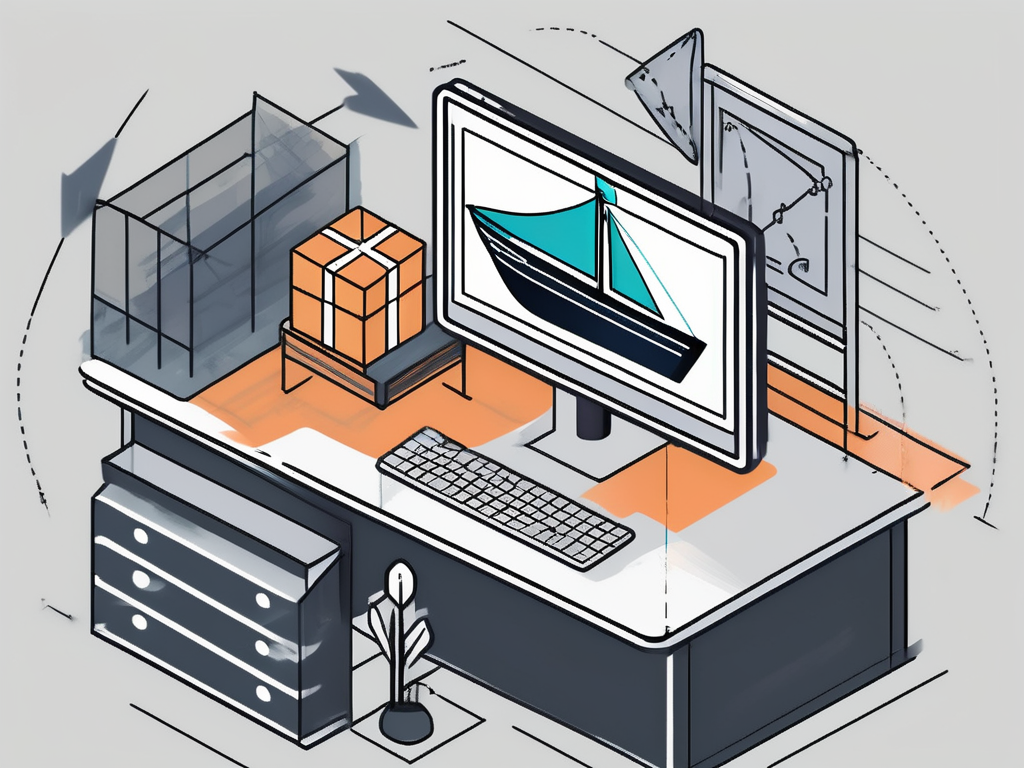Dropshipping has become an increasingly popular business model in recent years. With the rise of e-commerce and the ease of starting an online store, many entrepreneurs have turned to dropshipping as a way to start their own businesses with minimal upfront costs. In this comprehensive guide, we will delve into the basics of dropshipping, the step-by-step process, the advantages and disadvantages, and provide you with valuable tips for running a successful dropshipping business.
Understanding the Basics of Dropshipping
Defining Dropshipping: What is it?
Dropshipping is a business model where online retailers sell products to customers without having to stock inventory themselves. Instead, the retailer purchases the items from a third-party supplier who then fulfills the order by shipping the product directly to the customer. In essence, the retailer acts as a middleman between the customer and the supplier, earning a profit by marking up the price of the products.

The Role of Suppliers in Dropshipping
Suppliers play a crucial role in the dropshipping process. They are responsible for manufacturing, storing, and shipping the products to customers on behalf of the retailer. Finding reliable and trustworthy suppliers is essential to ensure smooth operations and customer satisfaction.
The Importance of E-commerce Platforms
E-commerce platforms are the foundation of a dropshipping business. These platforms provide retailers with the tools and features necessary to manage their online store, showcase products, process orders, and handle customer inquiries. Popular e-commerce platforms include Shopify, WooCommerce, and Magento.
When it comes to dropshipping, having a user-friendly and robust e-commerce platform is crucial. These platforms offer a wide range of features that can help retailers streamline their operations and provide a seamless shopping experience for customers. For example, many e-commerce platforms provide inventory management tools that allow retailers to keep track of their stock levels and automatically update product availability on their online store.
Furthermore, e-commerce platforms often offer integrations with various payment gateways, making it easy for retailers to accept payments from customers. This eliminates the need for manual payment processing and reduces the risk of errors or delays in the payment collection process. Additionally, some platforms offer built-in marketing tools, such as email marketing and social media integration, to help retailers promote their products and reach a wider audience.
Another important aspect of e-commerce platforms is their ability to handle customer inquiries and provide support. Many platforms offer customer support features, such as live chat or ticketing systems, allowing retailers to quickly respond to customer questions or concerns. This level of responsiveness can greatly enhance the customer experience and build trust between the retailer and the customer.
In conclusion, while dropshipping relies on the partnership between the retailer and the supplier, the choice of e-commerce platform is equally important. By selecting a reliable and feature-rich platform, retailers can effectively manage their online store, streamline operations, and provide an exceptional shopping experience for their customers.
The Dropshipping Process: Step by Step
Choosing Your Niche and Products
Before diving into dropshipping, it’s important to choose a niche that aligns with your interests and has a potential customer base. Conduct market research to identify profitable product categories and select products that have demand but are not oversaturated in the market.
When choosing your niche, consider your own passions and hobbies. By selecting a niche that you are genuinely interested in, you will have a better understanding of your target audience and be able to connect with them on a deeper level. For example, if you are a fitness enthusiast, you might consider dropshipping fitness equipment or activewear. This personal connection can help you create compelling marketing campaigns and build brand loyalty.
Additionally, it’s important to keep an eye on current trends and consumer preferences. Stay updated on popular products and emerging markets to ensure that your chosen niche has long-term potential. By staying ahead of the curve, you can position yourself as a leader in your niche and attract a loyal customer base.
Finding Reliable Suppliers
When it comes to dropshipping, finding reliable suppliers is key to success. Look for suppliers who offer competitive pricing, quality products, and efficient shipping methods. Consider establishing relationships with multiple suppliers to mitigate the risk of disruptions in the supply chain.
When evaluating potential suppliers, it’s crucial to do your due diligence. Read reviews and testimonials from other dropshippers to get an idea of their reputation and reliability. Reach out to them directly to inquire about their processes, lead times, and return policies. A reliable supplier will be responsive, transparent, and willing to work with you to ensure customer satisfaction.
Furthermore, consider the location of your suppliers. If you are targeting customers in a specific region, it may be beneficial to work with suppliers located in that region to reduce shipping costs and delivery times. This can result in happier customers and fewer logistical challenges.
Setting Up Your Online Store
Once you have chosen your niche and suppliers, it’s time to set up your online store. Select an e-commerce platform that suits your needs, customize your store’s design, and optimize it for search engines. Make sure to create clear and compelling product descriptions, enticing product images, and an easy-to-navigate user interface.
When designing your online store, think about the overall user experience. Consider how customers will navigate through your website, search for products, and make purchases. A seamless and intuitive user interface can significantly improve conversion rates and customer satisfaction.
Additionally, invest time in optimizing your store for search engines. Conduct keyword research to identify relevant search terms and incorporate them into your product descriptions, meta tags, and URLs. By ranking higher in search engine results, you can attract more organic traffic and increase your chances of making sales.
Managing Customer Orders and Shipping
As orders start coming in, it’s important to efficiently manage customer orders and shipping. Communicate with your suppliers to ensure timely order fulfillment, track shipments to provide customers with updates, and promptly address any customer inquiries or concerns. Customer satisfaction is key to building a successful dropshipping business.
Consider implementing a robust order management system to streamline the process. This can help you keep track of inventory levels, automate order fulfillment, and generate shipping labels. By automating repetitive tasks, you can focus on providing exceptional customer service and growing your business.
Remember, communication is key when it comes to managing customer orders. Keep your customers informed about the status of their orders, provide tracking numbers, and promptly address any issues that may arise. By keeping your customers in the loop, you can build trust and loyalty, resulting in repeat business and positive word-of-mouth referrals.
Advantages and Disadvantages of Dropshipping
The Pros of Dropshipping
One of the major advantages of dropshipping is the low startup costs. Since you don’t need to invest in inventory upfront, you can focus your resources on marketing and building your brand. This means that even if you have limited funds, you can still start your own business and enter the e-commerce world. With dropshipping, you have the opportunity to turn your entrepreneurial dreams into reality without breaking the bank.

Furthermore, dropshipping allows you to offer a wide variety of products without the burden of managing inventory and logistics. This flexibility gives you the freedom to experiment with different product lines and cater to various customer preferences. Whether you want to sell trendy fashion accessories or niche hobbyist items, dropshipping enables you to curate a diverse product range that appeals to your target audience.
The Cons of Dropshipping
While dropshipping offers numerous benefits, there are also disadvantages to consider. One of the downsides is the lower profit margins compared to traditional retail models. Since you’re not manufacturing or storing the products, you have less control over pricing and may face increased competition. However, with strategic pricing and effective marketing, it is still possible to generate a healthy profit margin in the dropshipping industry.
Additionally, relying on suppliers for order fulfillment introduces the risk of stockouts and shipping delays. As a dropshipper, you are dependent on your suppliers to promptly ship the products to your customers. While most suppliers strive for efficiency, unforeseen circumstances such as high demand or logistical challenges can lead to delays. It is crucial to establish strong relationships with reliable suppliers and maintain open communication to mitigate these risks and ensure a smooth order fulfillment process.
Tips for a Successful Dropshipping Business
How to Choose Profitable Products
Choose products that are in demand, have high-profit margins, and cater to a specific target audience. Conduct thorough market research and analyze trends to identify products with potential. Consider factors such as competition, shipping costs, and customer demand when selecting your product offerings.

Building Strong Supplier Relationships
Establishing strong relationships with your suppliers is crucial for long-term success. Communicate regularly to maintain transparency, address any issues promptly, and negotiate better pricing or shipping terms as your business grows. By fostering positive relationships, you can ensure reliable service and efficient order fulfillment.
Effective Marketing Strategies for Your Dropshipping Business
Marketing is vital for attracting customers to your dropshipping store. Utilize a mix of digital marketing channels such as social media advertising, search engine optimization (SEO), influencer marketing, and email marketing to generate awareness and drive traffic to your store. Build a strong brand presence and engage with your audience to foster trust and loyalty.
In conclusion, dropshipping is a lucrative business model that has gained popularity due to its low startup costs and flexibility. By understanding the basics, following a step-by-step process, and implementing effective strategies, you can build a successful dropshipping business. With careful planning, continuous learning, and attention to customer satisfaction, you can turn your dropshipping venture into a profitable online business.

